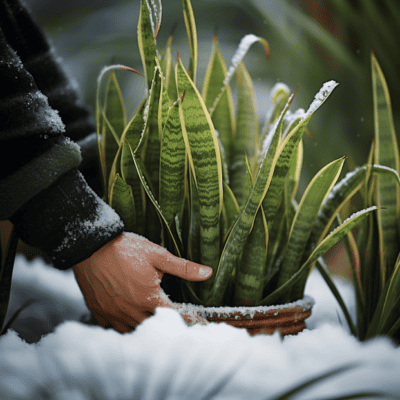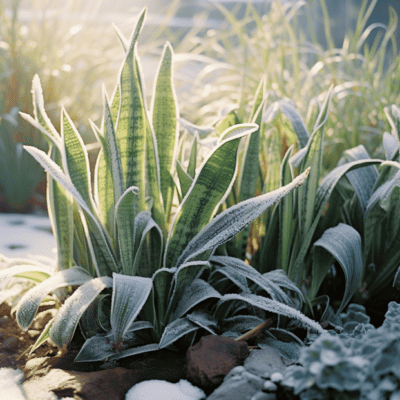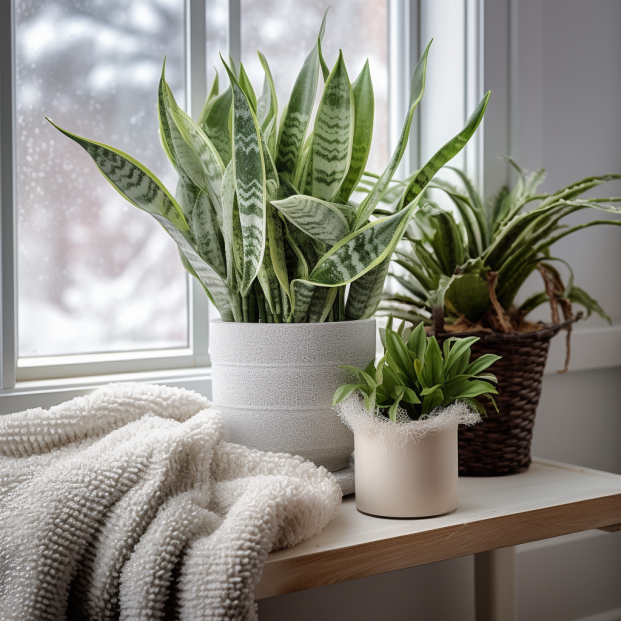If your snake plant got too cold, it may have suffered from cold damage.
According to Gardening Dream, the leaves of a snake plant can turn soft and mushy if exposed to cold temperatures. (1)
In this guide, I will discuss all about saving snake plants that got too cold, so if you have this problem, keep reading.
KEY TAKEAWAY
Snake plant got too cold, what to do?
Cold-damaged snake plants can be revived with proper care, including addressing specific symptoms and optimizing their environment.
Understanding the signs of cold stress is crucial for implementing timely rescue strategies and maintaining a healthy snake plant.
Is My Snake Plant Doomed? Understanding Cold Damage
Snake plants are tropical plants that prefer warm temperatures between 60-80°F.
If snake plants experience cold temperatures below 50°F or freezing temperatures, they can show signs of cold damage like:
- Drooping leaves
- Curling leaves
- Leaves turning brown or yellow
This happens because the cold causes damage to the plant’s cells.
If your snake plant was exposed to the cold, check the leaves and roots. Damaged leaves will be mushy and brown. Healthy leaves are firm and green. Root rot from wet soil makes cold damage worse.
If most leaves are damaged, the snake plant likely cannot be saved. But if just some leaves show damage, the plant may recover by growing new, healthy leaves in warmer temps.
Reviving a Chilled Snake Plant: Effective Strategies for Recovery
If your snake plant only shows minor cold damage, take these steps to help it recover:
- Cut off any damaged leaves – this concentrates growth into new leaves
- Check soil moisture – root rot makes cold damage worse
- Move to warmer spot with temperatures between 60-80°F
- Give more direct sunlight – snake plants prefer at least some sun
| Factor | Ideal Range |
| Temperature | 60-80°F |
| Sunlight | At least 2-3 hours of direct sun |
| Water | Enough to keep soil slightly moist |
With improved care optimized for warmth and sun, mildly damaged snake plants can regrow fresh new leaves within weeks. So don’t give up on your chilled snake plant yet!
With a little TLC, it can bounce back from frozen hardship.
Tools and Tips for Snake Plant Cold Care

Thermometer/Hygrometer Combo
This 2-in-1 tool monitors both temperature and humidity levels.
It empowers you with the knowledge to maintain the ideal conditions for snake plants.
Fluctuations in temperature and moisture impact plant health and can worsen cold damage.
Pruning Shears
These allow you to cleanly trim off any leaves that are badly damaged by the cold.
Removing dead material helps the snake plant concentrate its energy into growing new, healthy leaves instead.
Well-Draining Potting Soil
This soil formulation improves drainage to prevent overwatering.
Excess moisture in soil can lead to root rot, especially if the plant is also stressed by chillier temperatures.
Indoor Plant Grow Light
Supplemental light aids snake plants growing slowly due to cold weather.
It mimics brighter, longer summer days which stimulates faster growth and recovery.
Rooting Hormone
This encourages the formation of new roots.
It can be applied to healthy snake plant cuttings, allowing you to propagate new plants if the original suffered extensive cold damage.
Insulating Plant Cover
Wrapping outdoor snake plants protects them from extreme cold exposure during winter nights.
Insulating materials like burlap maintain warmer conditions for the plant.
Indoor Plant Fertilizer
Feeding with a balanced fertilizer provides nutrients to fuel growth of new leaves.
Fertilizer supports comeback from cold stress once warmer conditions return.
Identifying Symptoms: Yellow or Brown Drooping Leaves

Snake plants are tropical plants that thrive in warm temperatures between 60-80°F. If temps drop below 50°F, you may notice:
- Leaves turning yellow or brown
- Drooping leaves that are soft and limp
- Slowed growth
This happens because extreme cold damages the plant’s cells.
The discolored, drooping leaves indicate that your snake plant needs help recovering from the cold shock.
Step-by-Step Rescue: Dealing with Brown Leaves
Follow this first aid plan to nurture your snake plant back to health if its leaves turned brown from cold:
- Cut off all brown leaves – this saves the plant energy
- Check the root ball – root rot makes cold worse
- Repot in fresh potting soil with drainage holes if roots are rotted
- Move to a warm spot with temperatures between 65-80°F
- Give bright indirect light for at least 2-3 hours a day
- Resume normal watering once it recovers, letting the soil dry between waterings
With this TLC to treat the damaging effects of the cold, your snake plant can regrow fresh new leaves in no time.
Be sure to protect your snake plants from drafts and extreme temperatures in the future!
Optimal Conditions: Soil, Pots, and Drainage for Snake Plant Resilience
To make snake plants as resilient as possible to temperature drops:
- Use porous potting soil so excess moisture can evaporate
- Plant in pot with drainage holes to prevent overwatering
- Water only when soil is partly dry to keep root system healthy
Healthy snake plants can better withstand cold stress. Optimizing soil, drainage, and watering sets up the plant to stay vigorous when temperatures get low.
Curling Leaves Crisis: Rescuing Your Snake Plant

If your snake plant develops curling or browning leaves after cold exposure:
- Cut off damaged parts of the plant to reduce stress
- Check root system – treat root rot if found
- Move to warmer area between 65-80°F
- Give indirect sunlight for 2-3 hours a day
- Resume normal watering once new growth emerges
Snake plants are quite low maintenance and can rebound well from periods of cold temperatures with proper care.
Maintain optimal soil, light, and warmth to nurse your plant back to health.
Winter Survival: Understanding Snake Plant Temperature Tolerance
Snake plants cope better with low temperatures than many houseplants since they dormantly survive hot African winters. But how cold is too cold?
While snake plants can handle brief nights down to 40°F, prolonged exposure below 55°F causes concern. (2)
Growth may dramatically slow and leaves can wrinkle, curl, or brown.
So a chilled garage or enclosed porch is too frigid for long-term winter quarters.
Inside a 50-65°F living room is the best spot to overwinter snake plants.
Preventing Cold Damage: Tips for a Robust Snake Plant
You can keep your snake plant vigorous and cold-hardy with optimal care:
- Water properly – dry out completely, then water thoroughly. Too much moisture risks root issues.
- Give bright, indirect light year-round for growth and strength
- Keep in nighttime temperatures above 55°F
- Varieties under 3 feet tall cope better with cold
If you provide great growing conditions through the winter, your snake plant will stay healthy enough to withstand brief cold exposures while dormant.
Frequently Asked Questions
What should I do if my snake plant’s leaves are curling?
If your snake plant’s leaves are curling, it likely means the plant has been exposed to temperatures lower than its ideal temperature range.
Snake plants prefer temperatures between 60-80°F.
Curling leaves can happen when temperatures drop below this range.
The leaves may return to normal once the plant is moved to a warmer area with temperatures within the ideal range.
What causes a frozen snake plant’s leaves to turn brown or yellow?
If a snake plant’s leaves are turning brown or yellow after the plant was frozen, it’s a sign the temperatures were too cold for the plant.
Snake plants, whose botanical name is sansevieria trifasciata, can tolerate some cooler temperatures but may show damage if frozen.
Brown or yellow discoloration on the leaves is a symptom the plant has been stressed from temperatures lower than it can withstand.
How do I care for a snake plant whose leaves are turning brown or yellow?
If your snake plant’s leaves are turning brown or yellow, first check that the growing conditions meet the plant’s needs.
Snake plants prefer bright indirect light and temperatures within the 60-80°F range.
Ensure the plant is getting indirect sunlight and is not in a spot that gets direct sun, which can cause additional stress.
Check that the soil has drainage holes and is well-draining potting soil to avoid overwatering.
The discolored leaves may continue to brown as the plant recovers, but new growth should emerge healthy if conditions improve.
Trimming off fully brown leaves can help the rest of the plant focus its energy on new growth.
What can I do to keep my snake plant healthy after it has been exposed to cold temperatures?
After a snake plant has been exposed to cold temperatures that caused damage, there are some things you can do to help it recover and keep it healthy going forward.
Move the plant to a warmer area with temperatures within the ideal 60-80°F range for snake plants.
Check the root ball and gently remove any parts that are blackened or mushy due to cold damage, being careful not to disturb healthy roots.
You can also replace the soil if it becomes compacted from excess water when the plant was cold.
Ensure the new pot has drainage holes and use a well-draining soil.
Provide indirect sunlight and avoid overwatering.
Maintaining stable temperatures, light levels, and soil moisture will give the plant the best chance to recover.
Why are parts of my snake plant turning yellow or brown?
There can be a few reasons why parts of a snake plant may be turning yellow or brown.
One potential cause is temperature stress if the plant has been exposed to temperatures lower than the ideal 60-80°F range it prefers.
Root damage from overwatering poor-draining soil is another possibility.
Root rot from soggy soil can cause discolored foliage.
Sunburn from too much direct sunlight can also stress the plant.
Check growing conditions like temperature, light levels, soil drainage and watering frequency to determine what may be causing the discoloration so conditions can be adjusted to keep the rest of the plant healthy.
Conclusion
The snake plant did not do well in the cold weather.
Its leaves turned brown and soft when the temperature dropped.
This shows that snake plants prefer warm weather.
They originated in hot, tropical areas.
If your snake plant was damaged by the cold, do not worry.
Cut off the dead leaves.
Then move it to a warmer spot indoors.
Check the soil to see if it needs water.
With some care, your snake plant can recover.
The cold caused harm, but these sturdy plants can bounce back.
Has your snake plant survived cold weather? Tell us about it below!
References
- https://gardeningdream.com/snake-plant-cold-damage/
- https://hoorayplants.com/how-cold-can-snake-plants-tolerate/#:~:text=According%20to%20experts%2C%20snake%20plants,F%20(20%C2%B0C).
Related Articles
- https://knowngarden.com/how-to-save-your-frozen-snake-plant/
- https://knowngarden.com/bad-temperature-for-snake-plant/
- https://knowngarden.com/how-to-revive-dead-snake-plant/








